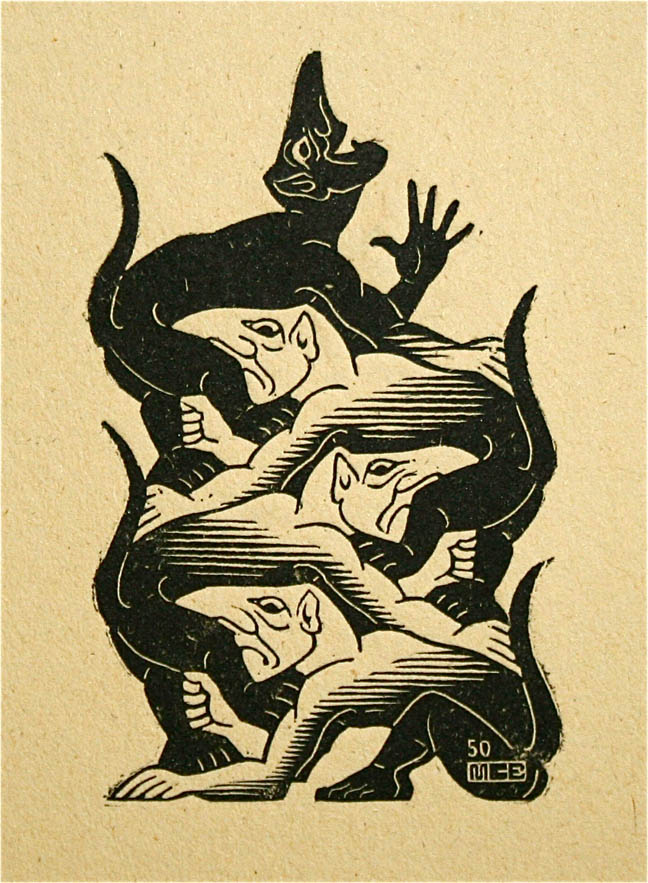

Title: Unsigned printmakers proof by artist Maurits Cornelis Escher
Shipping: $18.00
Artist: N/A
Period: 20th Century
History: N/A
Origin: N/A
Condition: Museum Quality
Item Date: 1920 to 1972
Item ID: 2316
The Artist Maurits Cornelis Escher (1898-1972) born in Leeuwarden, is one of the world's most famous graphic artists. The unique art of the Dutch printmaker M. C. Escher, who died in 1972 and created images that are often seen on posters and tee shirts as well as in art museums. One of the few collections of original Escher prints. This is a unsigned printers proof from a carved woodblock from M. C. Escher. Few people have ever seen an original artwork by Escher. He worked alone in Holland, and didn't gain international fame until rather late in his life. Since then the demand for the few original prints Escher created has been phenomenal, and exhibits of his work regularly break museum attendance records. The estate will not verify the print proof. Most artist proofs are not aloud on the open market and most are destroyed by the artist or sometimes have been given as a gift. These prints where almost always made on inferior paper. Escher's work covered a variety of subjects throughout his life. His early love of portraits, Roman and Italian landscapes and of nature, eventually gave way to regular division of the plane.. Over 150 colorful and recognizable works testify to Escher's ingenuity and vision. He managed to capture the notion of hyperbolic space on a fixed 2-dimensional plane as well as translating the principles of regular division onto a number of 3-dimensional objects such as spheres, columns and cubes. A number of his prints combine both 2 and 3-dimensional images with startling effect.. His art continues to amaze and wonder millions of people all over the world. In his work we recognize his keen observation of the world around us and the expressions of his own fantasies. . M.C. Escher shows us that reality is wondrous, comprehensible and fascinating.
Link: http://en.wikipedia.org/wiki/M._C._Escher
M.C. Escher, during his lifetime, made 448 lithographs, woodcuts and wood engravings and over 2000 drawings and sketches. He is most famous for his so-called impossible structures, such as Ascending and Descending, Relativity, his Transformation Prints, such as Metamorphosis I, Metamorphosis II and Metamorphosis III, Sky & Water I or Reptiles. Many of these sketches he would later use for various other lithographs and woodcuts and wood engravings like the trees reflecting in the woodcut Puddle, which are the same trees Escher used in his woodcut "Pineta of Calvi", which he made in 1932. Maurits Cornelis Escher, born in Leeuwarden, 17 june 1898, received his first instruction in drawing at the secondary school in Arnhem, who helped him to develop his graphic aptitude by teaching in the technique of the linoleum cut. From 1919 to 1922 he studied at the School of Architecture and Ornamental Design in Haarlem, where he was instructed in the graphic techniques by S. Jessurun de Mesquita, whose strong personality greatly influenced escher's further development, as graphic artist. In 1922 he went to Italy and 1924 settled in Rome. During his 10 year stay in Italy he made many study-tours, visiting Abruzzia, Calabria, Sicily, Corsica and Spain. In 1934 he left Italy, spent two years in Switzerland and five years in Brussels before settling in Holland in 1941, where he died on march 27, 1972, at the age of 73 years.
M.C. Escher had became fascinated by the regular Division of the Plane, when he first visited the Alhambra, a fourteen century Moorish castle in Granada, Spain in 1922. During the years in Switzerland and throughout World War II, he vigorously pursued his hobby, by drawing 62 of the total of 137 Regular Division Drawings he would make in his lifetime. He would extend his passion for the Regular Division of the Plane, by using some of his drawings as the basis for yet another hobby, carving beech wood spheres. He played with architecture, perspective and impossible spaces. His art continues to amaze and wonder millions of people all over the world. In his work we recognize his keen observation of the world around us and the expressions of his own fantasies. M.C. Escher shows us that reality is wondrous, comprehensible and fascinating.